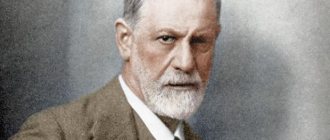Updated July 22, 2021 610 Author: Dmitry Petrov
Hello, dear readers of the KtoNaNovenkogo.ru blog. Motive plays a key role in our lives, but not everyone fully understands what it is.
The fact is that this term has many meanings, as it is used in various spheres of life - fine arts, literature, music, biology and even criminology.
But today we will talk about motive as a concept of psychology. All our actions and inactions are justified by motives, their strength, stability and direction.
Therefore, today we will talk about this in the simplest possible language and with examples.
What is motive
Motive
- this is a process that controls human behavior, contributing to its organization, direction, activity and stability. It is also believed that a motive is a certain generalized image of material or ideal objects that are valuable to an individual.
Achieving these objects is the meaning of his activity for him. To a person, a motive is presented in the form of special experiences that can be both positive (when expecting to achieve these objects) and negative (when realizing the incompleteness of one’s position, the lack of this object). Schopenhauer was the first to use the concept of “motivation” in psychology.
Nowadays, the word “motivation” in psychology is understood in different ways. Some researchers believe that this is a set of processes responsible for motivation and activity; while others believe that it is a purely mental phenomenon, representing a collection of motives.
What is motivation in psychology in essence? This concept is used where they talk about achieving a certain goal and specific ways to achieve this. It is known that the same goal can be achieved in different ways. So, if a person wants to become rich, then he can get a job in a prestigious company, open his own business, write a good book, engage in criminal activity... And vice versa - the same action can be performed for different purposes. In addition, the desire to achieve a specific goal can also be explained by one’s own considerations. Why does a person want to get rich? Someone wants to buy a mansion by the sea, someone wants to get married, someone wants to professionally do what they love (and not something that just generates income). In such cases, they say that a person is guided by certain motives.
Usually, a person organizing some kind of activity and achieving a certain goal is guided by several motives at once, which is why psychologists talk about one or another motivation. The problem of motivation in psychology is one of the most difficult. Often a person himself does not realize exactly what motives he was guided by when he performed some actions. There are hidden motives associated with some memories, fears, etc. Such motives are not reflected in consciousness and act on a subconscious level; a person only feels some kind of vague tension, discomfort, which he strives to overcome with the help of certain actions.
Thus, a goal is what we want to achieve, and a motive is the reason why we want to achieve it. Motivation in psychology is understood as both the set of motives that control an individual’s behavior and the process of this control itself.
Varieties of motives
The classification of motives is very broad: they are divided into groups, correlating them with their various properties and characteristics - according to their focus and content, levels and types.
For a general acquaintance with this phenomenon, it is enough to know their types :
- The conscious motive manifests itself in the form of attitudes, stereotypes, beliefs (I help those in need because I consider mercy (what is it?) a valuable quality and therefore develop it in myself).
- Unconscious ones are drives, the meaning of which a person does not understand (I do something, but I don’t understand why. For example, I drink water, but I don’t realize that I’m thirsty).
- Social – associated with communication in society (what is this?), self-realization.
- Cognitive – gaining knowledge, development.
- Incentive - encourage a person to act (if you want to eat, but do not do anything to satisfy your hunger, you will die in 10 days).
- Sense-forming – give meaning to activities.
- External - someone pushes a person to do some activity (“Study, son, good, you’ll become president”).
- Internal – true motivations – what the individual himself wants (“I don’t want to be president, I’ll become a hipster”).
- Real – conscious and adequate situations.
- Imaginary - far-fetched, not related to reality (the desire of an adult to lose weight when weighing 40 kg).
Types of motives in psychology
Psychologists identify a large number of types of motives, dividing them into several categories. It is not easy to create such a classification, since there are a lot of circumstances that guide a person; Each direction of psychology and each school has its own system. However, the most widespread division of motives into four groups.
Internal and external motives
These types are important not only in terms of the choice of means and ways to achieve the goal, but also for the self-realization of human individuality. Internal motives are such as interests, hobbies, the need for positive emotions and avoidance of negative ones, the desire to increase self-esteem, etc. These circumstances are related to the person himself and his attitude to his activities.
External motivation is circumstances that do not depend on a person and his desires and lie outside his personal sphere. These may be motives such as public opinion, a change in weather, the desire to get a higher grade or avoid punishment, etc.
External and internal motivations can work simultaneously, or they can act separately. For example, a student diligently does his homework. He can do this both because he is interested in the topic, and in order to get a good grade, please his parents, brag to his friends, etc.
External motivation plays a fairly large role in human life, since most people need a certain socialization. Such motives are often more effective than internal ones; this is the same “kick in the ass” without which some people will not do anything at all. However, for personal development, internal motives are still the most preferable. Only with their help can you do your work truly productively. All creative activity is based primarily on internal motivation.
Positive and negative motives
Like needs, drives are associated with emotions. A person in his actions can be driven by the desire to receive pleasure, pleasure, and then this is a positive motivation, or he can also be driven by the desire to avoid punishment, pain, fear and other negative experiences, and then this is a negative motivation.
Researchers cannot yet definitively say which of these motives are more effective in achieving a goal. Negative motivation can encourage one to overcome obstacles, endure minor inconveniences, and work until exhaustion; but it also destroys a person who will never truly love or understand his business. Therefore, positive motives still seem more preferable.
Sustainable and unstable motives
Stable motivations are those that are based on human needs and do not require any additional reinforcement. Such motives have existed for quite a long time. Unsustainable motivation changes quickly. Thus, the internal motivations of the individual are stable, since changes in worldview, interests, and tastes occur rarely and gradually. External motivation, on the contrary, is unstable, since the demands of society, the mood of others, and the weather outside change quickly.
Achieving success
This is a separate type of motivation that has become relevant recently. Modern society sets a person up for success from childhood. It is not prestigious to be unsuccessful; success brings with it material well-being, public recognition, and other benefits. Success increases a person's social status.
It would seem that every person wants to achieve success. However, in reality, there are many obstacles on the way to achieving it, which sometimes discourage the desire to achieve success altogether. One of the reasons for this is a person’s lack of understanding of why he needs to achieve this goal. It happens that the set goal is too far away and gets lost among the many obstacles that arise; in this case, it is advisable to break the achievement of this success into several intermediate goals.
Often achieving great success involves leaving the so-called comfort zone. This means sacrificing something small in order to get something much bigger in the end; the ability to take risks, endure small troubles with the expectation that these problems will be more than compensated for when success is achieved. And this is where many potentially successful people give up.
Often the “comfort zone” is presented as a physical, mental, ideological or spiritual space in which a person feels good and comfortable, he does not suffer and, it would seem, is provided with everything he needs. In fact, psychologists understand something different by this concept. For some people, the “comfort zone” is associated precisely with suffering, inconvenience, pain, and leaving this zone can relieve suffering and bring happiness. But a person does not want to make this exit; he feels “good” when he feels bad. What is the reason for this paradox?
This situation is perfectly illustrated in the famous play “Dragon” by E. Schwartz, based on which a film was made in the late 80s. The inhabitants of the fairy-tale city come to terms with the fact that a terrible dragon has established dictatorial rule over them, who sets his own rules and, in particular, regularly demands that the most beautiful girls in the city be given to him. When a brave knight appears and kills the dragon and gives the inhabitants freedom, they immediately... elect a new dictator who makes them suffer in the same way. It turned out that the residents could not make an effort to learn to live without any dictators and suffering: in their minds, freedom, thinking, responsibility and hard work seem to be even greater suffering than the insane rules of this or that dictator, which one can get used to. The dragon freed people from the need to think and gave them, albeit unfair and deceitful, but a simple and understandable picture of the world, which was enough to learn by heart.
External and internal motivation in human life
Both external and internal motivation play an important role in a person’s daily life. Extrinsic motivation is characterized by the receipt of a stimulus from the outside, that is, a person primarily engages in some kind of work in order to receive reward, praise or recognition in society. A striking example of the external motivation of a working person is wages, provided that the work itself does not arouse his interest and does not bring much pleasure.
According to theories of human motivation, its internal appearance is in no way connected with external circumstances and a person chooses a certain activity primarily because it brings him pleasure. For example, he draws not to win a competition, but to get positive emotions. These two types of motivation in the life of an ordinary person are closely related and often the same activity is supported by several motives.
Types of Human Motivation
Such types of motivation as “carrot” and “stick” are widely known. This is nothing more than an idea of negative and positive motives. These principles have long been used in economics, politics, management, education and other areas, including everyday life.
It is interesting that these types of motivations can characterize not only an individual, but also a certain society. It is known, for example, that since ancient times the Russian consciousness has been more characterized by “stick” motivation than “carrot” motivation. This is even reflected in the proverbs: “Until thunder strikes, a man will not cross himself.” A similar character of the Russian person was noted by researchers of culture and even religion. Thus, one church historian said that Russian Orthodox people have long believed not so much in God as in the devil, and in Russian religious (and for the most part folk-religious) culture, thousands of ways and advice have arisen on how to avoid meeting with evil spirits; at the same time, original Orthodoxy condemns such a practice, because if a person believes in “an all-powerful God,” then he should not be afraid of evil spirits.
“Gingerbread” is largely a Western system of motifs. Thus, in European countries there are a number of incentives for citizens who strictly comply with the law, and a relatively mild system of punishments for those who violate the laws. In our country, the opposite is true: practically nothing is provided for law-abiding citizens, but the system of punishments is extensive, confusing, cruel and clumsy.
However, in modern Western society the role of the “stick” in certain areas is also growing. There, cruel treatment of children and violation of discipline in enterprises are severely condemned. The existing problems, say, in public health care in themselves are a “stick” for Europeans, encouraging them to work hard to pay for private medical services.
Which of these motives are most effective? Each country and each people has its own answer to this question. History shows that European society was favorably influenced by the widespread increase in the “carrot”, that is, the development of positive motives; but opposite trends led to revolutions, strikes, spontaneous and organized mass protests. This has been evident in European history for centuries.
In modern Singapore, the “whip” played a key role in the prosperity of society. There are a great many restrictions and prohibitions in this city-state, and in order to maintain impeccable order, punishments such as caning are widely used. There are no “carrots” for citizens here. And it seems strange to many of us how such methods have led Singapore to an economic and social miracle, high standards of living, social cohesion (and this in a multi-ethnic and multi-cultural country with a high population density) and the absence of mass discontent.
The countries of Eastern Europe, the USA, and China stand out in that their societies maintain a certain balance of incentives. For Eastern Europe, this was especially noticeable during the years of the Soviet bloc: citizens loyal to the state regime, who worked conscientiously and cared about their high “moral character” (from the point of view of the authorities), were guaranteed a fairly high standard of living, a certain degree of civil liberties, provision of consumer goods. And next to this is the brutal persecution of dissidents, dissidents, “parasites,” and the condemnation of an immoral way of life, elevated to ideology. Something similar could be seen in these countries both before and after the “Soviet era.” Only people who were characterized by a struggle between opposing systems of motives could build such a society. To compare this with the Western European system, just look at the prisons in these countries: Norwegian or Dutch ones are more reminiscent of resort hotels, and Polish or Romanian ones are more like a concentration camp.
This makes some sense. In the cultures of different countries, the image of a prison is given the role of a kind of “scarecrow”, with the help of which some people try to motivate others, thereby controlling their behavior. In Russia, the USA, China and the countries of Eastern Europe, a prison is not a correctional institution, but an “institution for the execution of punishments,” and its task is to oppress and destroy the individual, to destroy the criminal morally and often physically. And only the desire not to “slide” to the point of ending up behind bars gives the average person in these countries the impetus to perform socially useful actions (work, provide for their family, respect others, do not steal, do not kill, etc.). The first opportunity to avoid a prison sentence motivates a typical resident of these countries to commit a crime.
The behavior of Europeans is subject to different principles. Apparently, a prison term does not frighten them: after all, the existing restrictions in the prisons there do not humiliate the prisoner as an individual, the prison staff show him a certain respect. But at the same time, the discipline of Europeans, their politeness, and desire to work hard (but not overwork) is amazing. If you leave a wallet with money on a bench in some German city, then, most likely, a week later you will find it there completely untouched (currently the situation is much different due to the abundance of migrants in Germany and other European countries who have completely different psyche). The reason is that the average European is determined to achieve success and maintain his good reputation, and any “wrong” action can ruin this reputation. You won’t go to jail, but your friends will turn away from you, your girlfriend will stop loving you, your parents will kick you out of the house, you won’t be hired by a good organization...
If you delve into history, you can see what motivated people in different countries, creating similar inventions, performing the same actions. A good example is the creation of a printing press. Johannes Gutenberg was definitely positively motivated: with the help of his printing house, he wanted to improve his financial condition, gain fame and influence, become a pioneer of something new, and give people new opportunities for development. He was the creator, chief worker and owner of his enterprise. In fact, he succeeded in his plans: not only merchants and artisans, but also royalty and the church became his clients.
The Russian pioneer printer Ivan Fedorov was motivated by slightly different considerations. For him, his work was rather ritual; he wanted to “serve God.” The visible analogues of “god” for him were rulers, church hierarchs, and boyars. In the first Moscow printing house, opened by the Tsar and Metropolitan for personal needs, Fedorov was a powerless worker, and he did not want to have any personal benefits from this enterprise. For a long time, the pioneer printer was driven by circumstances that did not allow him to fully implement his plans: ordinary priests and book copyists were angry with him, the printing house was quickly burned and forced him to flee the country to Lithuania, and then to Ukraine. Outside Russia, the pioneer printer's business went much better, but again at the expense of strong rulers. The Russian pioneer printer never acquired his own personal printing house. Apparently, the Christian god and government officials were for Fedorov a kind of “whip” that should be feared and served.
“The Man in the Case” is another character, now literary, who was clearly motivated solely by the “whip”. His favorite saying was the expression “no matter what happens,” which he repeated whenever he saw something unusual. Those around him were surprised where this petty official, a quiet and inconspicuous man, suddenly awakened with remarkable energy, with which he began to scribble complaints left and right. All-encompassing fear prompted him to act, while those around him were motivated in their actions by positive considerations.
Motivation for activity
As the pace of life in the world accelerates, people increasingly strive to achieve successful self-realization.
Since there are more and more people who are willing and actively express their position in life, a significant part of the activity of a modern person is aimed at leadership. In order to be a successful competitive person, you need to be able to correctly set goals for yourself and achieve them, but this is often hampered by fatigue from the pace of life or ordinary laziness - both options are an indicator of low motivation for activity. Thus, motivation for activity is a very pressing problem today, and scientists from both the field of psychology and related sciences are studying motivation for activity.
In Russian psychology there are various approaches to the study of personality. orientation as its leading characteristic . Most often in the scientific literature, orientation is understood as a set of stable motives that orient the activity of an individual.
It should be noted that the orientation of the individual is always socially conditioned and formed in the process of education. Moreover, the basis of all forms of personality orientation are the motives of activity .
Forms of personality orientation : attraction, desire, aspiration, interest, inclination, ideal, worldview, belief.
Let us briefly characterize each of the identified forms of orientation in the order of their hierarchy. First of all, you should focus on attraction. It is generally accepted that attraction is a mental state that expresses an unconscious or insufficiently conscious need.
Desire is a conscious need and attraction to something very specific. It should be noted that desire, being sufficiently conscious, has a motivating force.
The next form of focus is aspiration . Aspiration arises when a volitional component is included in the structure of desire. An impulse that expresses the need for conditions of existence that are currently absent, but can be created as a result of specially organized activity of the individual.
Interest is a specific form of manifestation of a cognitive need that ensures that the individual is focused on understanding the goals of the activity and thereby contributes to the individual’s orientation in the surrounding reality.
Interest in the dynamics of its development can turn into an inclination. This happens when the volitional component is included in interest. Propensity characterizes an individual’s orientation towards a certain activity.
An ideal is the objective goal of an individual’s inclination, concretized in an image or representation, i.e. what he strives for, what he focuses on.
Worldview is a system of views on the objective world, on man’s place in it, on man’s relationship to the reality around him and to himself.
Conviction is the highest form of orientation - it is a system of motives of an individual that encourages her to act in accordance with her views, principles, and worldview. Beliefs are based on conscious needs that encourage a person to act and form his motivation for activity.
Motive is the motivation for activity related to satisfying the subject’s needs. Motive is also often understood as the reason underlying the choice of actions and actions, the set of external and internal conditions that cause the activity of the subject.
Types of motives:
1. Self-affirmation motive . This motive is closely intertwined with the individual’s self-esteem, his pride and ambition. A person tries to prove to society that he is worth something, wants to be valued and respected, and strives for a certain status in society.
2. Identification motive . This motive is based on the desire to be like an idol, a hero, a certain authoritative person. The motive encourages development and work on oneself. The identification motive is especially common among youth and children who try to be like other people in certain activities.
3. The power motive is based on the subject’s desire to gain power and the opportunity to influence the people around him. The need for power has at all times been one of the main forces driving human actions. This motive is quite strong. It allows an individual to overcome significant difficulties and make great efforts to achieve the goal.
4. Procedural-substantive motives represent an incentive to human activity through the content and process of activity. A person loves to perform this particular activity, he shows initiative and his physical or intellectual activity. Procedural-content motives are when a person likes the content and process of the work performed.
5. The motive of self-development is one of the main motives that forces a person to work on himself and develop. Moving forward and self-development are often quite closely related to intrapersonal conflicts, but are not violence against oneself.
6. Achievement motive – the desire to achieve excellent results and high skill in one’s activities. This desire usually manifests itself in the fact that the individual selects quite difficult tasks and tries to complete them. A person who is endowed with a high level of achievement motivation persistently works on himself to achieve his goal.
7. Prosocial motives are motives associated with one’s own awareness of the social significance of an activity and responsibility to society. When such motives operate, identification of the group with the individual occurs.
8. The affiliation motive is the desire to maintain relationships with other people, to communicate and contact with them. The meaning of affiliation lies in the intrinsic value of communication.
9. A negative motive is an impulse that is caused by the awareness of possible troubles, punishments, and inconveniences that occur in case of failure to perform an activity.
The term "motivation" is a broader concept than the term "motive". The word “motivation” is used in modern psychology in a dual sense:
as denoting a system of factors that determine behavior (this includes, in particular, needs, motives, goals, intentions, aspirations and much more),
as a characteristic of a process that stimulates and maintains behavioral activity at a certain level.
Most often in the scientific literature, motivation is considered as a set of psychological reasons that explain human behavior, its beginning, direction and activity.
Motivation is an important component of the regulation of any human activity. At different periods of a person’s life, different types of activities become significant. For a teenager, educational activity is necessary as the basis for subsequent successful functioning in society; accordingly, it is necessary to develop learning motivation.
The question of motivation for activity arises every time it is necessary to explain the reasons for a person’s actions. Moreover, any form of behavior can be explained by both internal (psychological properties of the subject) and external (conditions and circumstances of its activity) reasons. In the first case, they talk about motives, needs, goals, intentions, desires, interests, etc., and in the second, they talk about incentives emanating from the current situation. Intrinsic and extrinsic motivation are interconnected.
In turn, a motive, in contrast to motivation, is something that belongs to the subject of behavior himself and prompts him from the inside to perform certain actions. Motives can be conscious or unconscious. The main role in shaping a person’s orientation belongs to conscious motives.
It should be noted that the motives themselves are formed from human needs. Need is the state of a person’s need for certain conditions of life and activity or material objects. Needs always act only as sources of motivating power of motives.
It is known that in order for an activity to be carried out, sufficient motivation is necessary. However, if the motivation is too strong, the level of activity and tension increases, as a result of which certain disorders occur in activity (and behavior), i.e. work efficiency deteriorates. In this case, a high level of motivation causes undesirable emotional reactions (tension, anxiety, stress, etc.), which leads to deterioration in performance.
It has been experimentally established that there is a certain optimum (optimal level) of motivation at which the activity is performed best (for a given person, in a specific situation). A subsequent increase in motivation will lead not to improvement, but to deterioration in performance. Thus, a very high level of motivation is not always the best. There is a certain limit beyond which a further increase in motivation leads to worse results.
This relationship is called the Yerkes-Dodson law. These scientists established back in 1908 that in order to teach animals to go through a maze, the most favorable is the average intensity of motivation (it was set by the intensity of the electric shocks).
Achievement motivation - achievement-oriented behavior presupposes that every person has motives to achieve success and avoid failure. In other words, all people have the ability to be interested in achieving success and anxious about failure. However, every individual has a dominant tendency to be guided by either the achievement motive or the failure avoidance motive. In principle, the achievement motive is associated with productive performance of activities, and the failure avoidance motive is associated with anxiety and defensive behavior.
The predominance of one or another motivational tendency is always accompanied by the choice of goal difficulty. People motivated to succeed prefer goals that are moderate in difficulty or slightly exaggerated, which are only slightly greater than the result already achieved. They prefer to take calculated risks. Those motivated to fail tend to make extreme choices, some of them unrealistically borrowing, while others unrealistically inflate the goals they set for themselves.
After completing a series of tasks and receiving information about successes and failures in solving them, those who are motivated to achieve overestimate their failures, and those motivated to fail, on the contrary, overestimate their successes.
Successful performance of productive activities requires not only developed abilities, but also such important motivational characteristics as interest in the task being performed and faith in one’s ability to achieve a certain result. Simply possessing knowledge does not automatically ensure its use in various life situations. People with the same level of intellectual ability can differ significantly in how capable they perceive themselves to be in the face of the challenges they face, and this is reflected in their performance.
Achievement motivation is the desire to improve results, the desire not to stop there, perseverance in achieving your goals, the desire to achieve your goal despite difficulties.
Achievement activities can include intellectual, sports, work activities, as well as activities aimed at raising a child, helping others, or acquiring any social skills.
What distinguishes achievement motivation from avoidance motivation? According to various authors, the main distinctive features are the following categories of achievement motivation:
1) Independent goal setting by the subject;
2) The desire to achieve an independently set goal;
3) Lack of desire to please anyone in terms of goals, means and results of activities;
4) Preference for average or slightly above average complexity of tasks.
These four categories are basic in conducting any achievement motivation training and especially in diagnosing the level of achievement motivation.
Factors that determine the presence of strong achievement motivation:
1. The desire to achieve high results (success).
2. The desire to do everything as best as possible.
3. Selection of difficult tasks and the desire to complete them.
4. The desire to improve your skills.
The dependence of success on abilities and motivation to achieve
Success in activity, as is known, depends not only on a person’s abilities, but also on the desire to achieve a goal, on purposeful and persistent work to achieve success (i.e., on motivation to achieve). Based on this, we can propose the following formula for success:
U = C x M x St
Where
U - success;
C - ability;
M - achievement motivation;
St - situation (external factors, favorable circumstances, etc.).
Achievement motivation can be described by the following formula:
System model of the achievement motivation process
Analysis of modern theories of motivation for productive activity made it possible to formulate a holistic (generalizing) model of the process of motivation of activity, consisting of four main blocks, interconnected in a certain way.
The value-target block is a system of motives, goals and values that trigger behavioral, cognitive and emotional processes of motivation for achievement-oriented activities. It can be characterized by:
(1) target regulations, and, in particular, the goals that the subject sets for himself, as well as the expression and specific content of the internal and external regulation of the activity in question;
(2) the goals that the subject sets for himself, and
(3) value dispositions and interests of the subject.
Goals are a critical component of motivated behavior. The result of the activity depends on how clear, precise, difficult and attractive the goals are.
The value-target block has priority for determining whether the subject has motivation. It triggers all other components of motivation.
The cognitive block is a subsystem that includes, first of all, ideas about the controllability of the process and the result of activity, described through the following components:
1) ideas about personal responsibility for successes and failures (cf. belief in the controllability of the result),
2) belief in one’s ability to cope with a certain activity and
3) expectations of success or failure.
The emotional block of motivation for achievement activity can be characterized through (1) the presence of the experience of pleasure from efforts aimed at achieving results, and
(2) features of emotional reactions that the subject demonstrates when encountering difficulties and failures.
The behavioral block of achievement motivation represents a system of behavioral components of motivation and can be characterized through the following psychological components:
1) persistence, manifested in the time devoted to solving a problem (both in the sense of continuity of work on the task and in the sense of the duration of the pursuit of achieving the goal), persistence in the process of solving it, as well as bringing it to the end (obtaining a certain result) despite possible interference, for example, interruptions in work;
2) intensity of effort (level of energy and enthusiasm);
3) coping strategies (active, adaptive or helpless, avoidant);
4) selection of tasks of the optimal level of difficulty.
Perseverance is one of the most important indicators of motivation. An individual with high achievement motivation demonstrates persistence despite the difficulties that arise in the process of achieving a goal.
From this description of the structure of achievement motivation and its components, it follows that achievement motivation is a complex cognitive-emotional-behavioral formation and therefore it does not seem surprising that the understanding of this phenomenon is still not complete and consistent.
9 ways to increase motivation:
Focus on the end result
Everything you work on has a purpose. Even if the process itself is boring or unpleasant, the end result is worth it. So, having order in your head and a clear plan will increase your motivation and make your work easier.
Take a break
Sometimes, your motivation wanes because you work too hard and too hard. Take a break. Even a few minutes away from your computer can help you relax. It's also a great way to restore a sense of perspective if you're overwhelmed with tasks.
Go for a walk
One of the best ways to relax is to go for a walk. Even a five minute walk helps. You will get your body moving and warm up your blood. Then, you can return to your work feeling full of energy again.
Make a list of tasks
Sometimes, your motivation may plummet because you have too many tasks and you don't know where to start. Take everything out of your head and put it on paper. It will only take a few minutes and will make everything seem much more manageable.
Switch between two tasks
Do you have several big tasks that you need to complete? Find an alternative: work on one for ten to fifteen minutes, then on another, and so on. This helps keep you moving (if you only have ten minutes, you'll be able to focus better) and you won't get bored doing the same thing.
Race against time
Trying to cope with a tedious task? Set yourself a goal to work faster. Set a timer and try to beat it.
Write down everything you have already achieved
Maybe you feel like you're not making much progress towards your goal. If yes, then take a piece of paper and write down everything you have already done. Write down those real, big achievements that will remind you how much you have already overcome.
Seek support
It’s hard for one to deal with negative thoughts and loss of motivation. Seek support from friends, relatives, colleagues and like-minded people. Spend more time with them, share your victories and future ideas.
Have a big dream.
What, if not a dream, will motivate you to do what you do. But just having a dream won't be enough. Your dream should inspire you. It has to be real, but at the same time be big. It should push your potential beyond your comfort zone.
Exercise “Saboteur”
Exercise “Inner saboteur”
This exercise is an adaptation of a well-known Gestalt therapy technique.
► Goal
The saboteur—the negative side of your personality—appears when you don't expect it. He can dissuade you from a new business or ruin something already started. The ability to recognize and understand your saboteur (critic) is important in working on yourself. He says: “Why try, why get down to business? It’s all in vain”, “If you are not able to become the best, leave this business.” Therefore, obviously, one should avoid the negative influence of the internal saboteur.
Counterattack your saboteur
But you can counter him with your strong arguments and not give him the opportunity to dominate your aspirations.
Exercise
Convince your saboteur. Give counterarguments that would overcome its negative effect.
| Saboteur This is impossible to achieve. There are many other things to do and responsibilities. Don't rush, there's still time. There will be a lot of difficulties and obstacles that cannot be overcome. Is it necessary to take on this matter? You have a lot of important things to do. You won't succeed. You won't find support among your colleagues! There are people more competent in this matter. Don't bother. 10. This matter will take a lot of effort. Take care of yourself! | Counter argument But it's worth a try (we'll see!). But you can always allocate a little time for this. |
Exercise “Come up with a motto”
Exercise “Come up with a motto”
► Goal
Every person has certain principles that he strives to adhere to and which guide his behavior. Each individual acts according to his own internal attitudes and beliefs, and is guided by certain slogans.
For example, a purposeful and persistent subject, in his activities, can be guided by the principle: “No matter what, be sure to bring the matter to the end.” A self-confident person can be encouraged by the motto: “I can achieve this, nothing will stop me!” Or perhaps you will be inspired by the following slogan: “Whoever thinks and works is sure to win!”
You are capable of independently purposefully forming certain principles and beliefs in yourself that will help you achieve your goals. By choosing a motto, gradually getting used to it and acting in accordance with its content, you can easily assimilate it. By developing positive thinking in accordance with new internal attitudes and principles, you can change your motivational system.
Tasks
Imagine that you are a person with high achievement motivation (strive to achieve significant success).
Come up with a motto (slogan) using the presented options for their focus. The motto should appeal to you, inspire you to overcome difficulties and problems, and set you up for persistent work.
1st option: to develop perseverance and the ability to overcome difficulties and obstacles
2nd option: to form a purposeful, i.e. systematic work to achieve the goal
3rd option: to develop self-confidence
4th option: to develop the desire to improve, improve your skills.
3. Write your motto on the sign. Choose the appropriate color and symbol pattern. Use markers and stickers. Place the sign in your planner so you can see it at all times.
The struggle of motives
As already mentioned, a person is simultaneously driven by many different motives. And not all of them are equivalent and equally directed. Here's a classic example. A person sets an alarm clock at night, intending to get up early the next morning - for example, to go for a morning run. But the morning comes, the alarm clock rings, and this person no longer wants to get up. He finds himself in a situation where he needs to make a specific decision, and it depends on what motives prevail in him at the moment. Here we come across what is called willpower.
This example is not particularly critical, but there are situations in life when a person has to make very difficult choices. Any of the options for action is motivated in a certain way, and this brings discomfort and even real torment. So, in some cases we are faced with a choice - to save ourselves from trouble or to save our loved ones at the cost of our own lives. Such internal conflicts can lead to the development of depression or neurosis.
What should you do if you need to make such a choice? Experts advise not to give in to emotions and carefully consider all options if possible. There must be a rational approach here; you need to weigh all the pros and cons, the benefits and deprivations that the choice you make will bring. And above all, one should be guided by socially significant motives. After all, it often happens that we achieve our goal by “walking over our heads,” as a result of which friends, close people, and relatives turn away from us, as a result, we lose more than we gain.
A person is not aware of all his motives, but control of his motivational sphere is available to us. It is necessary to create a hierarchy of needs and motivations for yourself and focus on the most significant and important of them. Such a hierarchy will be associated primarily with social values.
The “pyramid of needs” compiled by the American psychologist Abraham Maslow is widely known. This system distributes needs into “lower” ones, which make humans related to other animals, and “higher” ones, which are unique to humans. It is curious that the lower needs are associated with the individual survival of the organism, while the higher ones pursue social goals. The highest needs are the need to understand one’s connection with the entire universe, and not just with one’s small group or human society in general.
Having certain needs, a person acquires the motivations associated with them. And they motivate him to do certain things. It happens that an activity seems “higher”, but in reality a person is guided by “lower” motives. So, a musician can create fashionable but primitive music just to feed himself (and generally make money). It happens that “for bread” people create real masterpieces. In other cases, setting “lower” goals is only an intermediate step, while in reality the person is motivated by higher considerations. Thus, the father of the family can take care of his health in order to have the strength to provide for his wife and children.
Theory of motivation: features of the content direction
The emphasis in this direction of motivation for a person is on the analysis of human needs and methods of their systematization. The influence of internal emotional-volitional impulses on the formation of personality behavioral characteristics is studied. These principles of the theory of motivation were adhered to by Maslow, Herzberg, McClelland, and Alderfer.
- Maslow's theory. The most important thing in this theory of motivation for any person is that needs are formed into groups, between which a strict hierarchy is observed. This theory of human motivation can be illustrated using a pyramid, at the base of which are basic physiological needs, and the top of the pyramid is the achievement of self-actualization.
- Alderfer's ERG theory. According to this theory of human motivation, all needs can be classified into one of 3 groups (existence, connections and growth). The difference between this theory of human motivation from Maslow's theory is that Maslow recognized only a unidirectional movement from lower to higher needs;
- McClelland's theory. If you study this theory of motivation, you can see that throughout life a person can acquire the needs of achievement, participation and dominance, and one of them has a strong influence on his character and behavior;
- Herzberg's theory. This theory examines the influence of material and intangible factors on the development of personality and its activities. This theory of human motivation is widely used by managers of firms and enterprises to optimize the work of employees;









